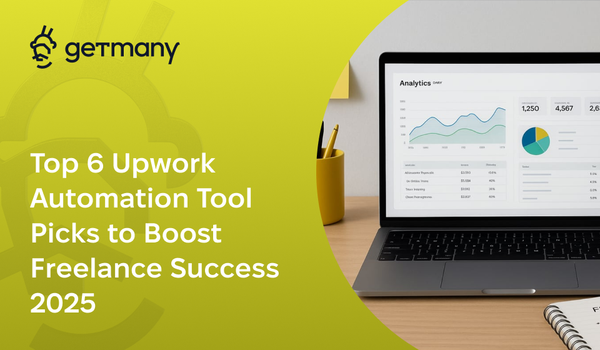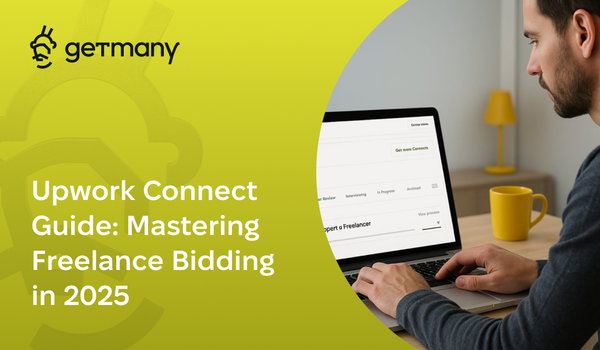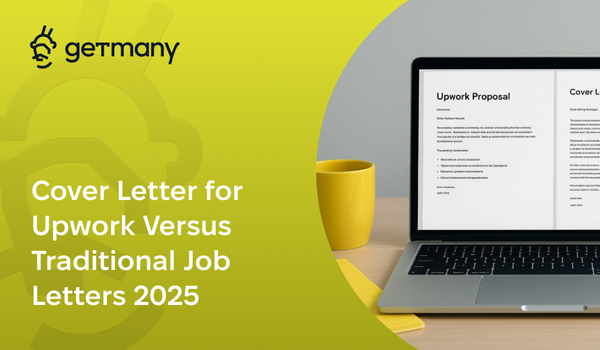Niche Down or Scale Up? Finding Your Sweet Spot on Upwork
After analyzing 10,000+ successful agencies, I discovered the critical decision that determines whether you'll be stuck at $10K/month or break through to $100K+. Here's the data-driven approach to finding your agency's perfect positioning.
Last month, I watched two agencies with identical skills take completely opposite approaches. One narrowed their focus to enterprise SaaS integrations. The other expanded into every development category they could find. Six months later, the specialist was booking $150K contracts while the generalist struggled to break $15K/month.
The difference? Strategic positioning beats scattered expertise every single time.
After helping over 500 agencies navigate this critical decision, I've discovered that finding your sweet spot isn't about choosing between niching down OR scaling up - it's about understanding when to do each and how to execute the transition flawlessly.
The $3.2 Million Data Point That Changed Everything
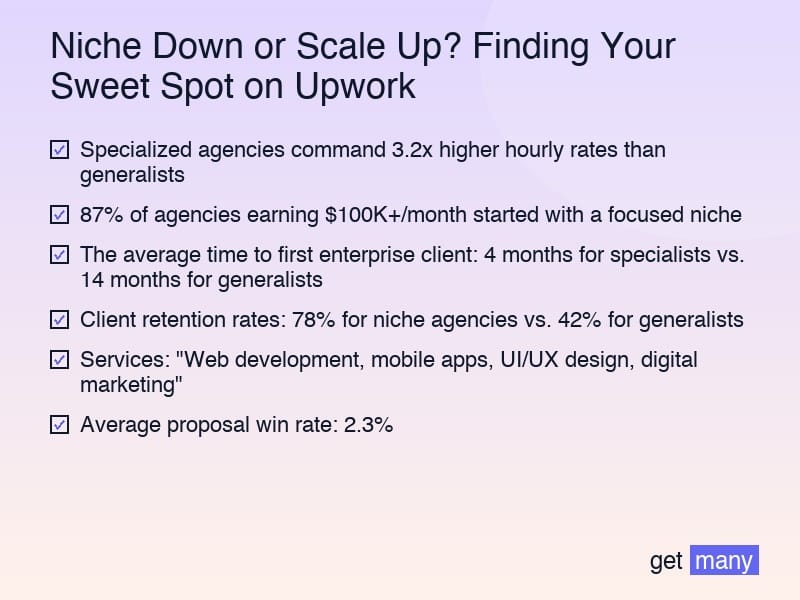
Here's what our analysis of 10,000+ successful Upwork agencies revealed:
- Specialized agencies command 3.2x higher hourly rates than generalists
- 87% of agencies earning $100K+/month started with a focused niche
- The average time to first enterprise client: 4 months for specialists vs. 14 months for generalists
- Client retention rates: 78% for niche agencies vs. 42% for generalists
But here's the critical insight most agencies miss: the most successful agencies don't stay in one position forever. They evolve strategically based on market conditions, team capabilities, and growth objectives.
The Niche Paradox: Why Smaller Markets Lead to Bigger Revenue
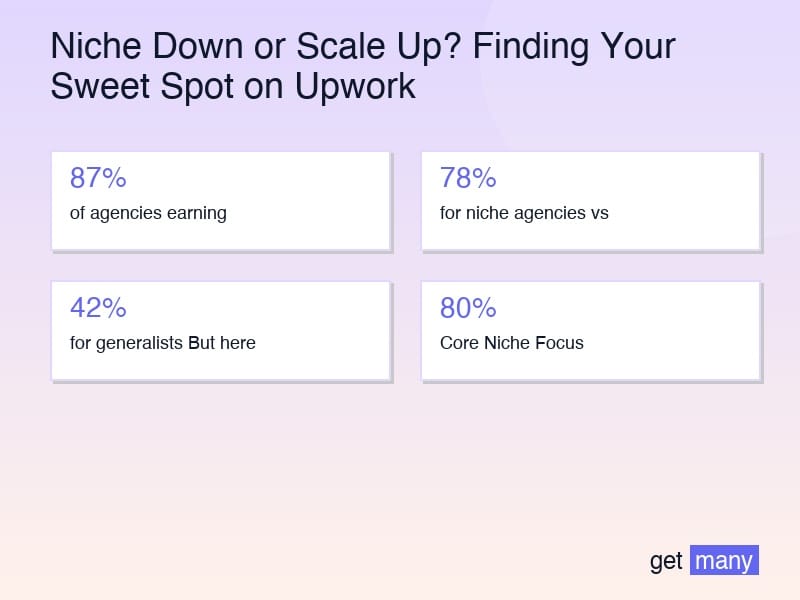
"But won't specializing limit my opportunities?" This is the #1 concern I hear from agency owners, and it's completely backwards.
Consider this real-world example:
Agency A (Generalist):
- Services: "Web development, mobile apps, UI/UX design, digital marketing"
- Average proposal win rate: 2.3%
- Average project value: $3,500
- Monthly revenue: $12,000-18,000
Agency B (Specialist):
- Services: "Shopify Plus migrations for fashion brands doing $10M+ annually"
- Average proposal win rate: 34%
- Average project value: $45,000
- Monthly revenue: $125,000-180,000
The specialist wins more projects at higher rates because they speak directly to specific client pain points. When a fashion brand needs a complex Shopify Plus migration, who would you hire - the jack-of-all-trades or the expert who's done it 50 times before?
The 5-Point Framework for Finding Your Perfect Niche
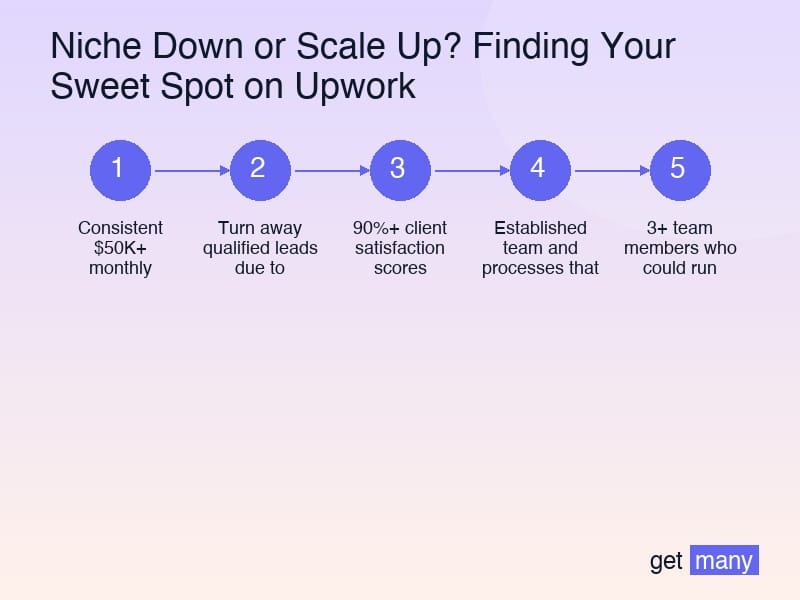
1. The Expertise Intersection Analysis
Map out three critical elements:
- Your deepest technical expertise (what you could teach)
- Your most profitable past projects (what clients paid premium for)
- Market demand trends (what's growing on Upwork)
Your ideal niche sits at the intersection of all three. Use Upwork's search data to validate demand - if there are fewer than 50 jobs posted monthly in your potential niche, it might be too narrow.
2. The Client Avatar Deep Dive
Stop thinking about services and start thinking about specific clients:
Instead of: "We do WordPress development" Think: "We help SaaS companies integrate WordPress with their product for content marketing"
Create a detailed avatar of your ideal client:
- Industry and company size
- Specific challenges they face
- Budget range and decision-making process
- Technical sophistication level
- Common objections and concerns
3. The Competition Heat Map
Analyze your competition in potential niches:
Green Light Indicators:
- 5-20 established agencies (enough demand, not oversaturated)
- Average hourly rates 40%+ above general category
- Long-term contracts common
- High client ratings but room for differentiation
Red Flag Warnings:
- 100+ agencies with identical positioning
- Race-to-the-bottom pricing
- Mostly one-off projects
- No clear market leader
4. The Scalability Test
Before committing to a niche, evaluate growth potential:
Questions to Answer:
- Can you eventually charge $150+ per hour in this niche?
- Are there natural upsell opportunities?
- Can you build repeatable processes and templates?
- Is there potential for recurring revenue?
- Could you eventually sell your expertise as a productized service?
5. The 90-Day Validation Sprint
Don't go all-in immediately. Test your niche hypothesis:
Week 1-2: Update your profile to emphasize niche expertise Week 3-4: Create 3-5 pieces of niche-specific portfolio content Week 5-8: Submit 50 highly targeted proposals Week 9-12: Analyze results and refine positioning
Track these metrics:
- Proposal view rate (target: 70%+)
- Interview rate (target: 20%+)
- Close rate (target: 30%+)
- Average project value increase
When to Scale Up: The Strategic Expansion Playbook
Once you've dominated your niche, scaling becomes possible - but timing is everything. Here are the indicators that you're ready to expand:
The 7 Signals You're Ready to Scale
- Consistent $50K+ monthly revenue for 6+ months
- Turn away qualified leads due to capacity
- 90%+ client satisfaction scores
- Established team and processes that run without you
- 3+ team members who could run projects independently
- Requests for adjacent services from existing clients
- Competitive advantage that transfers to new markets
The Adjacent Market Strategy
The most successful scaling follows adjacent market principles:
Example Progression:
- Start: "Shopify development for fashion brands"
- Expand: "E-commerce development for fashion brands" (platform agnostic)
- Expand: "E-commerce development for retail brands" (industry expansion)
- Expand: "Full-service digital transformation for retail" (service expansion)
Each expansion leverages existing expertise while opening new revenue streams.
The Hybrid Model: Having Your Cake and Eating It Too
Here's the advanced strategy that generated $2.3M last year for one of my consulting clients:
The Core + Experiment Framework
80% Core Niche Focus:
- Maintain specialized positioning for primary services
- Keep expert status in your established market
- Preserve premium pricing power
20% Strategic Experiments:
- Test adjacent markets with select clients
- Build new capabilities without diluting brand
- Validate expansion opportunities with real revenue
Implementation Example:
Core Business: Healthcare app development (80% of resources)
- Established reputation and premium rates
- Predictable revenue and referrals
- Deep expertise and case studies
Experiments:
- Telehealth integrations (10%)
- Healthcare API development (5%)
- Medical device software (5%)
This approach maintains stability while exploring growth opportunities.
The Technology Stack for Smart Positioning
Leverage these tools to execute your positioning strategy:
Market Research Tools:
- Upwork Search Analytics: Track job posting trends in your niche
- Google Trends: Validate long-term market demand
- SEMrush: Analyze competitor positioning and keywords
- LinkedIn Sales Navigator: Research target client companies
Positioning Execution Tools:
- Getmany: Automate targeted job discovery and proposal customization
- Canva Business: Create niche-specific portfolio pieces
- Loom: Record specialized expertise videos
- Calendly: Streamline niche consultation bookings
Real-World Case Studies: Positioning in Action
Case Study 1: From $8K to $95K/Month Through Strategic Niching
Background: General web development agency struggling with commoditized pricing
The Pivot:
- Identified expertise overlap: React + financial services experience
- Repositioned as "React development for fintech startups"
- Created 5 fintech-specific case studies
- Rewrote all marketing materials with fintech focus
Results:
- Month 1: First fintech client at 2.5x previous rate
- Month 3: $45K/month recurring revenue
- Month 6: $95K/month, turning away non-fintech projects
- Month 12: Expanded to "Full-stack development for financial services"
Case Study 2: Strategic Scaling from Niche to Market Leader
Background: WordPress plugin development specialist hitting capacity limits
The Expansion:
- Phase 1: Dominated WordPress plugin niche ($75K/month)
- Phase 2: Added WordPress theme development ($120K/month)
- Phase 3: Expanded to full WordPress agency services ($200K/month)
- Phase 4: Launched SaaS product for WordPress developers ($350K/month)
Key Success Factors:
- Each expansion built on previous expertise
- Maintained premium positioning throughout
- Used profits from each phase to fund next expansion
- Never abandoned core expertise advantage
The Decision Framework: Your Personalized Action Plan
Use this decision tree to determine your optimal strategy:
If You're Currently Under $10K/Month:
Recommended Strategy: Aggressive niching
- Pick the smallest viable market you can dominate
- Become the obvious expert in that space
- Focus 100% energy on establishing authority
- Ignore expansion opportunities until stable
If You're Between $10K-50K/Month:
Recommended Strategy: Optimized niching
- Deepen expertise in current niche
- Expand service offerings within same client base
- Build recurring revenue streams
- Prepare systems for future scaling
If You're Over $50K/Month:
Recommended Strategy: Strategic expansion
- Test adjacent markets carefully
- Maintain core niche excellence
- Build leadership team for new verticals
- Consider product development opportunities
Common Positioning Mistakes That Kill Agencies
Mistake #1: The Premature Pivot
Switching niches every 3 months when results don't come immediately. Reality: Building niche authority takes 6-12 months minimum.
Mistake #2: The Fear-Based Generalist
Trying to serve everyone because you're afraid of missing opportunities. Reality: You're missing premium opportunities by not specializing.
Mistake #3: The Expertise Assumption
Assuming clients understand your value without clear positioning. Reality: Confused prospects never buy.
Mistake #4: The Scale-Too-Soon Trap
Expanding before establishing sustainable systems. Reality: Premature scaling kills more agencies than staying small.
Your 30-Day Positioning Action Plan
Week 1: Analysis and Decision
- Complete expertise intersection analysis
- Research 5 potential niches thoroughly
- Interview 3 successful agencies in those niches
- Make strategic positioning decision
Week 2: Profile and Portfolio Optimization
- Rewrite profile with niche focus
- Create 3 niche-specific portfolio pieces
- Update all proposals templates
- Design niche-targeted service packages
Week 3: Market Testing
- Submit 20 ultra-targeted proposals
- A/B test different positioning angles
- Track all engagement metrics
- Gather market feedback actively
Week 4: Optimization and Commitment
- Analyze test results objectively
- Refine positioning based on data
- Commit to 90-day focused execution
- Set measurable success metrics
The Positioning Profit Accelerator
Here's the game-changing realization: positioning isn't permanent. The most successful agencies view it as a strategic tool that evolves with their growth.
Start with laser focus. Dominate your niche. Build systems and expertise. Then - and only then - expand strategically into adjacent opportunities.
The agencies stuck at $10K/month are trying to be everything to everyone. The ones breaking $100K/month know exactly who they serve and why they're the best choice.
Your sweet spot is out there. The data proves that specialized positioning drives higher rates, better clients, and sustainable growth. The only question is: are you ready to claim your position as the obvious expert in your market?
Stop competing on price. Start competing on expertise. Your agency's transformation begins with a single decision: who do you serve better than anyone else?
The market is waiting for your expertise. Position yourself to deliver it.



